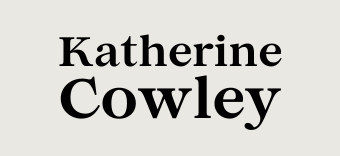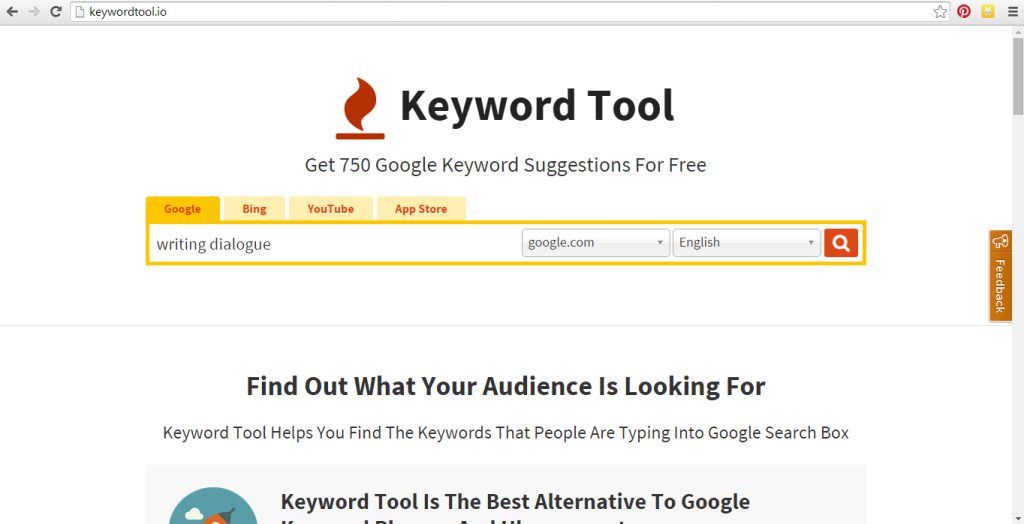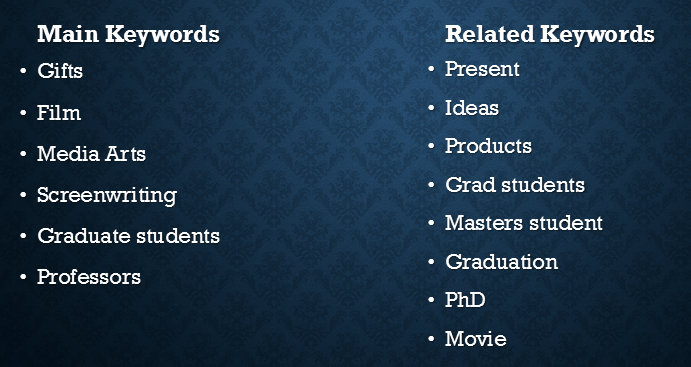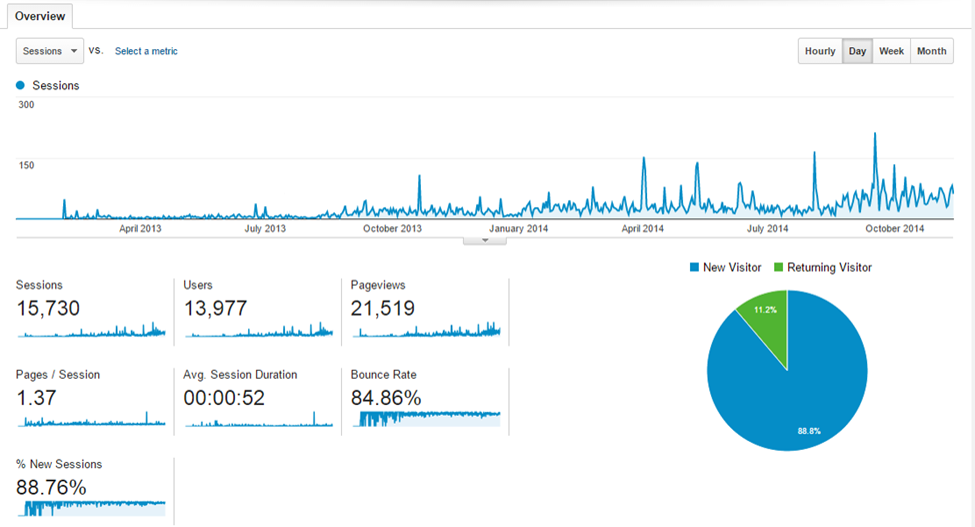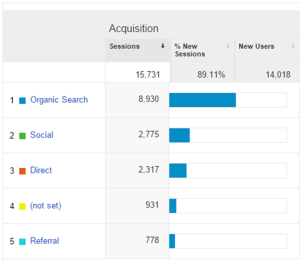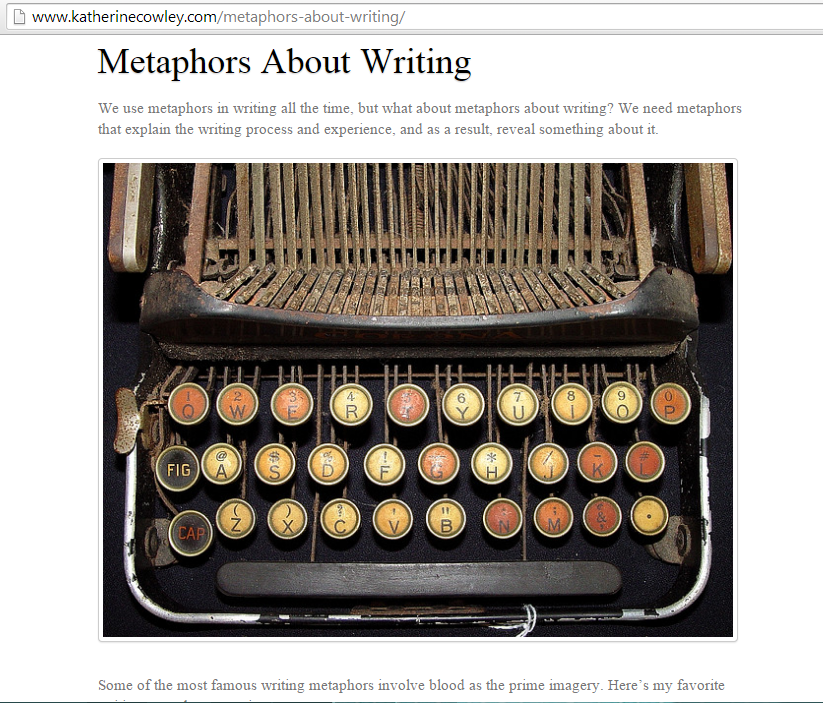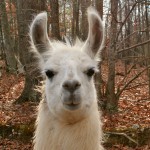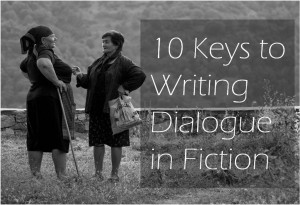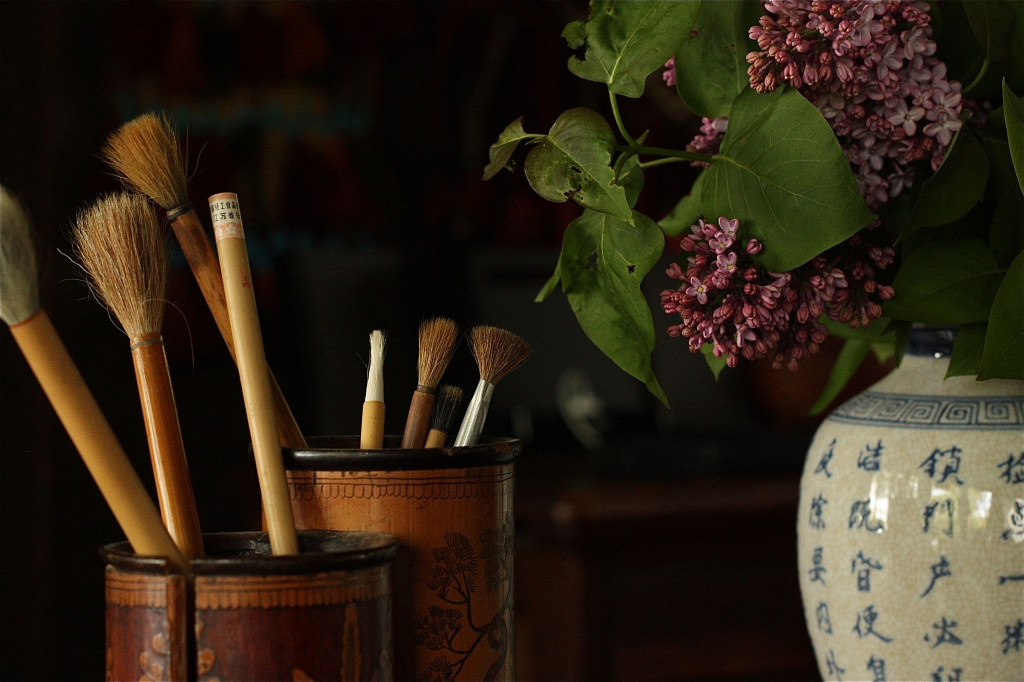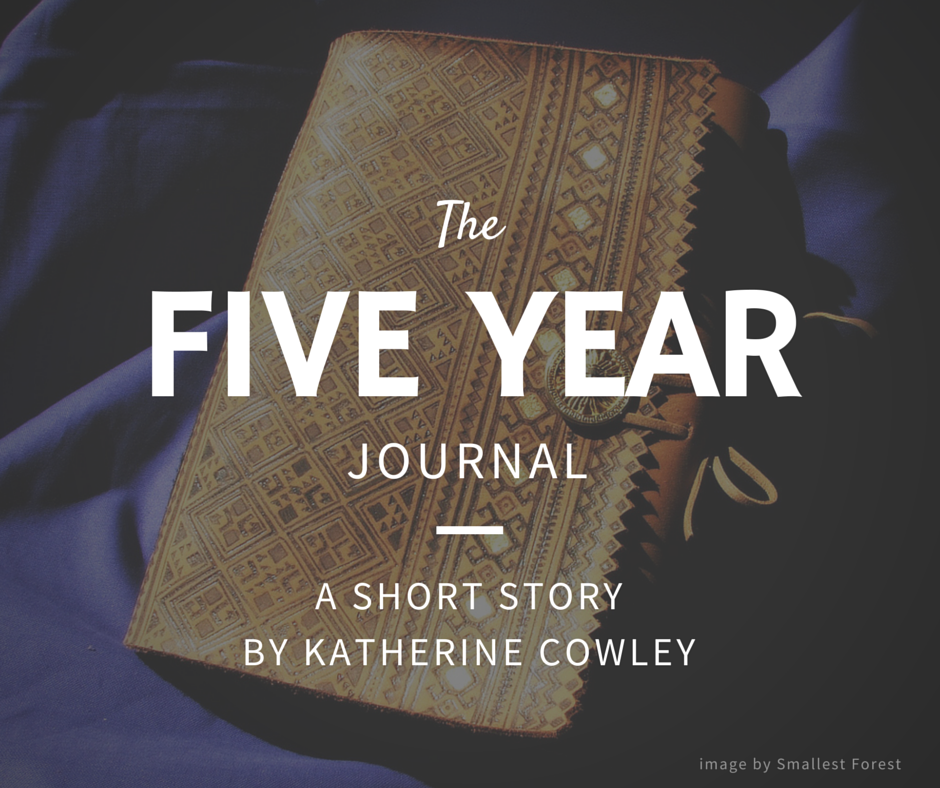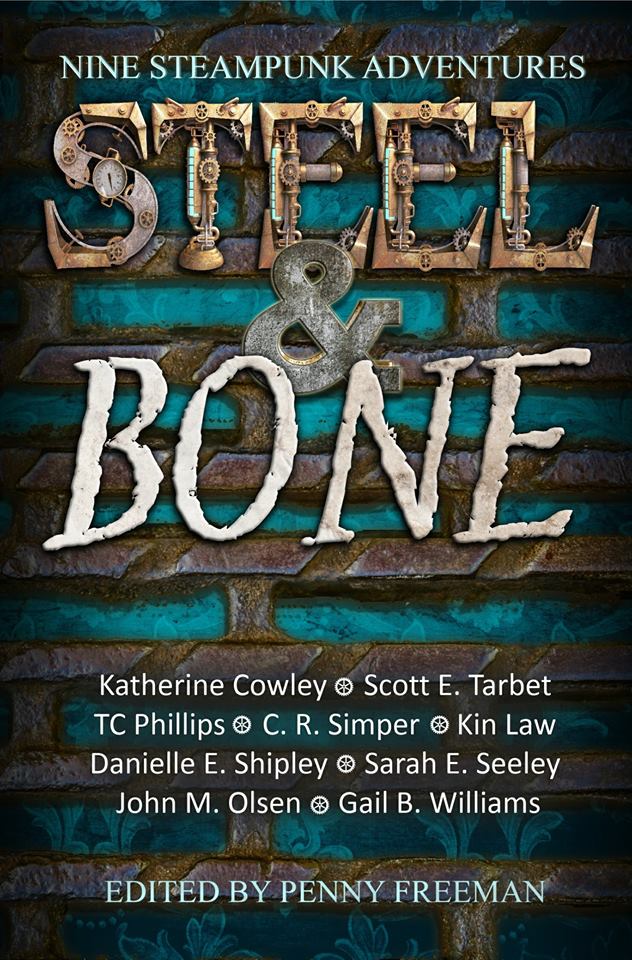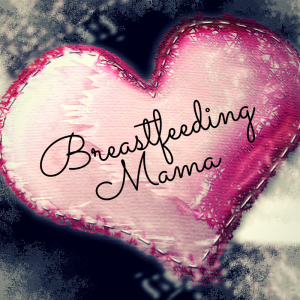Optimizing Your Author Website for Google
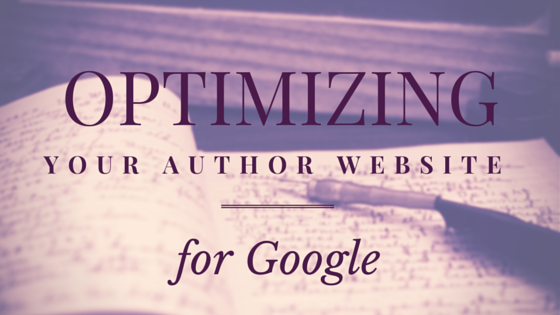
There’s a pretty standard consensus that organic search accounts for between 50 and 64% of website visits (the exact figure depends on the study’s approach). Search engines–including Google, Yahoo, and Bing–are the biggest driver of traffic on the web.
If you’re blogging or creating an author website, you need to make it possible for people to find you through search.
I’ve seen author websites that don’t show up when you Google the author’s name or their book title. And if you do a great post about x, y, or z, you want to have a website that shows up in search results.
In terms of search engines, in the United States Google accounts for 67% of searches. Bing and Yahoo are the two other big players. I’m going to focus on optimizing your author website or blog for Google; many of these techniques will help you show up in Bing and Yahoo as well.
First, How Does Google Determine Search Rankings?
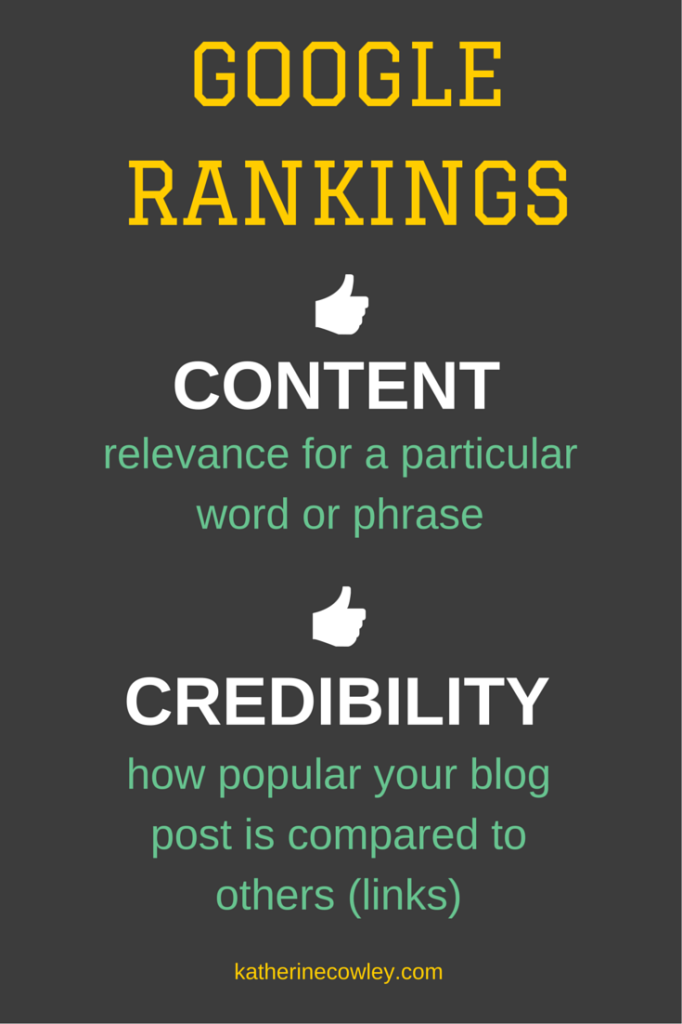
Google uses a complicated, ever-evolving algorithm, but it boils down to two big things:
1. Content: how relevant is the blog post for a particular word or phrase? If you want it to rank for something, it has to be clear to Google that the content is about a particular subject.
2. Credibility: how popular is your blog post compared to others with similar content? If everyone links to your post, and especially if big, important websites link to your post, then Google assumes your post is more credible.
Optimizing your author website is about focusing on the content and the credibility. Of course, some blog posts or pages are easier to optimize than others.
Types of Website Content
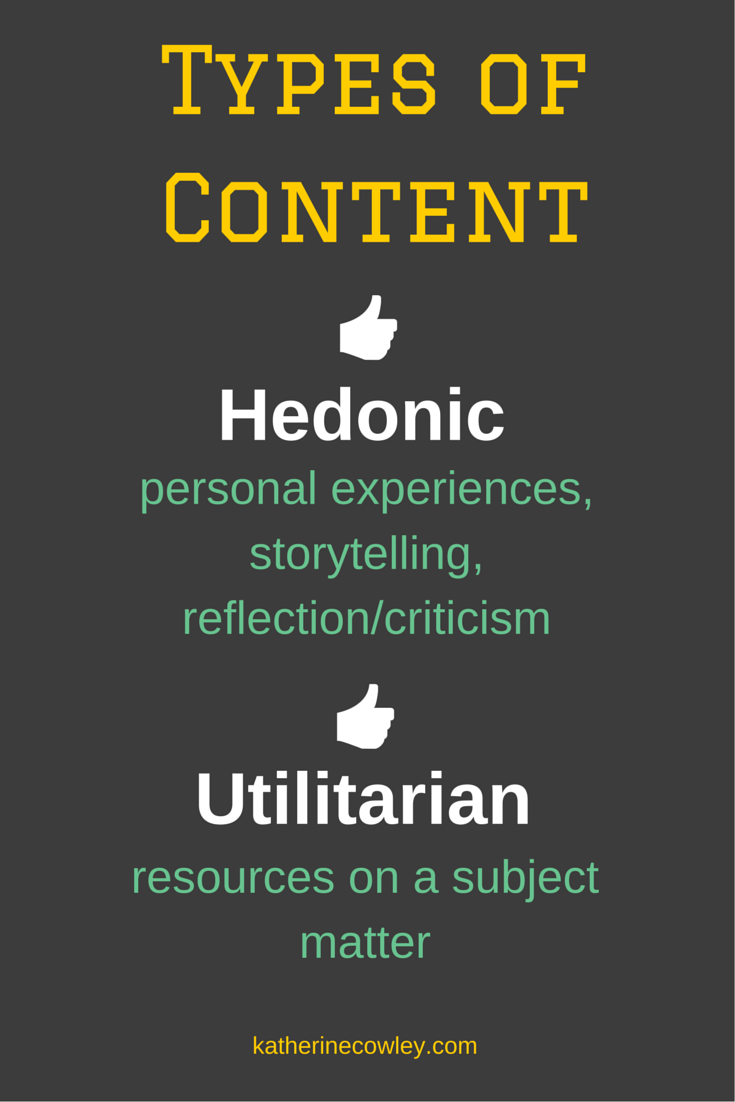
1. Hedonic Content: these are personal experiences, storytelling, and reflection or criticism. On an author website, this might be a short story or an essay you have written. Or if your books are about fishing, this might be commentary on fishing rules, reflections on fishing with your grandpa, or pictures from your latest fishing trip.
It is harder to optimize hedonic content for Google. There are a few ways to do it, which I address below (see especially Technique 7). But even though if you choose not to optimize your hedonic content for Google, you should definitely optimize it for Facebook and Pinterest.
2. Utilitarian Content: resources on a subject matter. On an author website, this might be tips on writing (like this blog post), or resources about a subject matter. For example, if you write fiction or nonfiction books about fishing, utilitarian content might be a list of the best fishing poles, a compilation of your favorite books on fishing, or information about a particular fishing location or technique.
You should always optimize utilitarian content for Google. This is where you can rank and find new readers for your website or blog, who in turn might be interested in your books or other stories.
And now, to get down to the practical, nitty gritty ways to optimize your content for Google. You don’t have to do all of these every time, but a little time spent optimizing can have big results.
Technique 1: Write an Awesome Blog Post or Website Page
If the content isn’t good, it doesn’t matter how well you optimize it.
As I wrote in the first blog post in this series (introducing the general principles of optimizing your author website), you can create stimulating content by considering the rhetorical situation: your audience, your subject matter, and what you personally have to offer.
If you’re a published author, make sure you have a separate website page for each of your books or stories, so your website or blog shows up for the term on Google. And then provide excellent content, such as frequently asked questions, deleted scenes, book group questions, character interviews, music playlist, links, etc.
Technique 2: Find Out What People are Searching For
Keywordtool.io is one of my favorite tools on the Internet. You type in a term and it tells you what people are searching for by using Google Autocomplete.
I wrote a blog post on Writing Dialogue, so I typed writing dialogue into Keyword Tool and searched. These were the results:
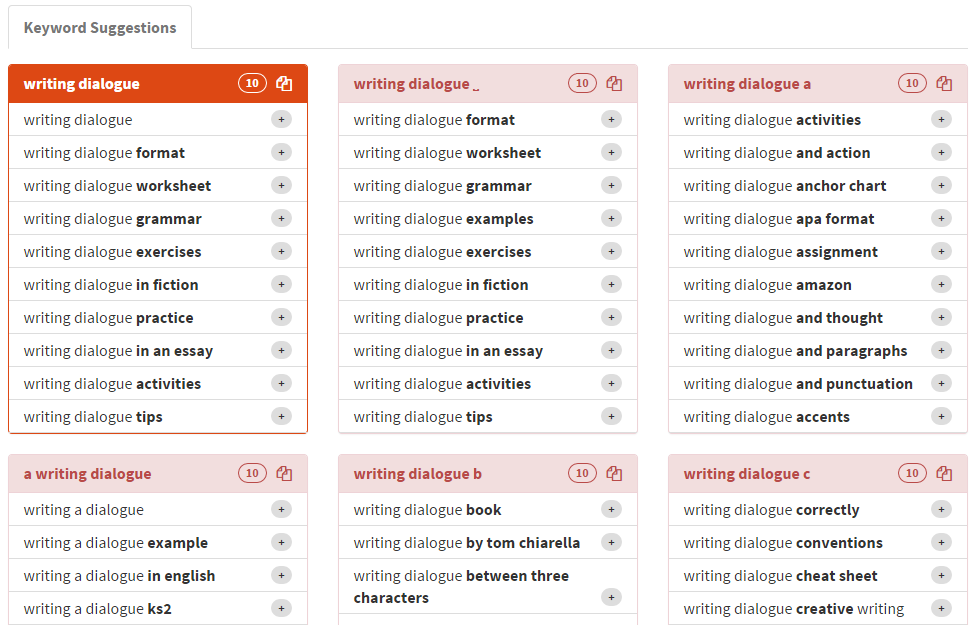
These phrases are the different keywords I could choose to target in my blog post. Writing dialogue is the obvious keyword, but when I search for that on Google, really big websites come up, like Writer’s Digest, NaNoWriMo, and Grammar Girl. They have so many links pointing to them that I know that I can’t compete for that term.
So I choose one or two other terms that I think I can compete for. For my particular blog post, I choose writing dialogue in fiction and writing dialogue exercises.
Technique 3: Include Your Keywords in Your Title, URL, and Post
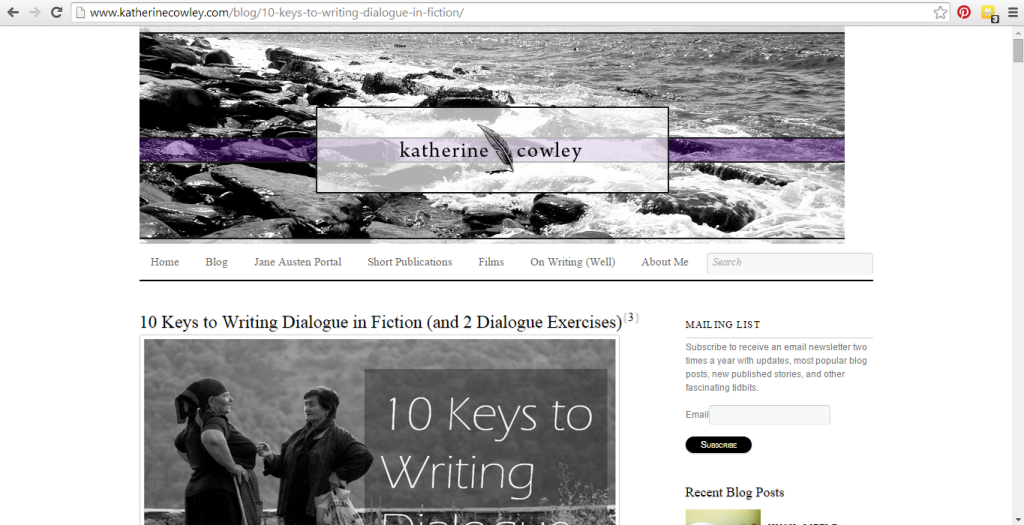
If a blog post on your website is truly focused on a particular topic, then that topic should be in the title and URL, right? Well, that’s what Google thinks at least. So if this is a topic that you think people were searching for, forget about doing a creative or clever title like The Dialogue of my Dreams. Instead, put in your keywords. As you can see above, the title of my post is 10 Keys to Writing Dialogue in Fiction (and 2 Dialogue Exercises) and the url ends with /10-keys-for-writing-dialogue-in-fiction/. I actually have WordPress set so that it automatically populates the URL with the blog post title (something you can do in most platforms) and then I modify it as I need to.
If one of my keywords is dialogue writing exercises, then I make sure that ends up multiple times in the post as well:
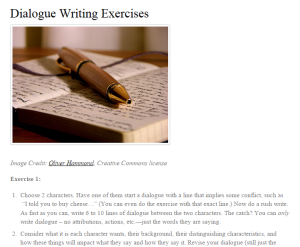
Technique 4: To Be Perfectly Optimized, Words Must be in the Exact Order as the Search
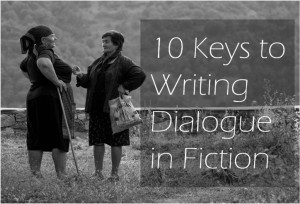
In my dialogue post, the terms I have perfectly optimized for in the title are writing dialogue in fiction and dialogue exercises.
In this blog post that you are reading, one of the terms I am optimizing for is author website, and optimizing your author website for google, so I’ve made sure to include those terms in the title, in the url, and multiple times throughout the post in that exact order.
A little gimmicky? Yes. But you found this blog post.
As a former writing teacher, I will confess that I will never sacrifice good writing just to insert keywords. Sometimes I consciously choose that it’s more important to have a short url that someone could type in then a long url that includes keywords. But if there are ways to insert keywords naturally, then I do.
Technique 5: Include Related Keywords in your Blog Post
There’s a chance that you will show up for related terms and keywords–but it’s a lot more likely if you include those related words in your blog post or website page.
For example, my husband and I were building an affiliate marketing website, which we’ve called Gift Some.
One of the pages we made was titled “Gifts for Film, Media Arts, and Screenwriting Graduate Students and Professors.” The main keywords are in our title and our post, but we’ve also chosen to include related search terms within the post. For example, someone might search for Presents for Film Grad Students. And so in addition to Gifts and Graduate students in our post we include the words Presents and Grad students.
Especially if you’re writing a utilitarian blog post, this is also something you can do to optimize your author website. But for good writing, you should be avoiding unnecessary repetition and using synonyms anyways.
Tip 6: Use Analytics
You don’t know what’s working on your website or blog if you don’t know how many people are visiting, what they’re looking at over time, and which blog posts are most successful for your audience. Some blogging platforms, like Blogger, come with some basic analytics included. Other don’t. But no matter what platform you are using, you can add Analtyics.
My favorite, free analytics is Google Analytics.It’s very robust and gives you lots details, and it’s also easy to use.
For Google Analytics, you can look at how your website is performing in real time, over a day, a week, a month, a year, or any time frame you want. Here I set my Analytics to a big-picture view to see how I increased my traffic over time:
Here I can analyze my best performing pages:
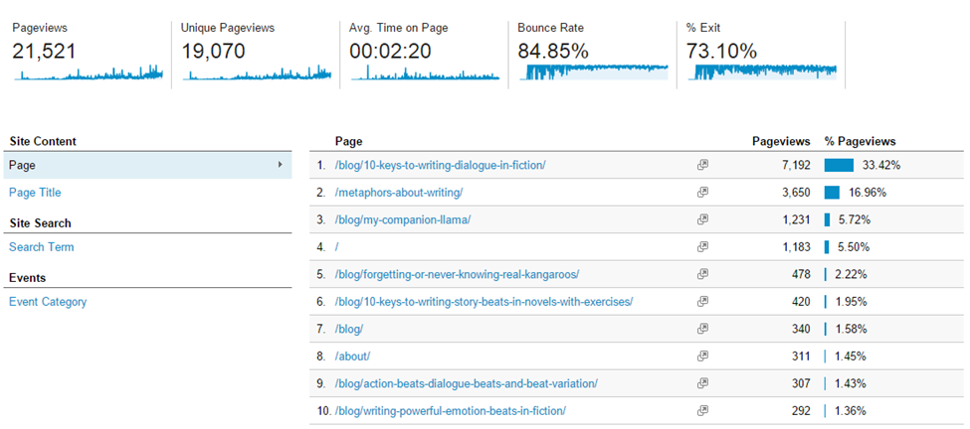
I can look at my traffic sources and see how people are finding my website or a specific post:
Within any category, I can break down the data. For example, which social networks are people using to get to my author website?
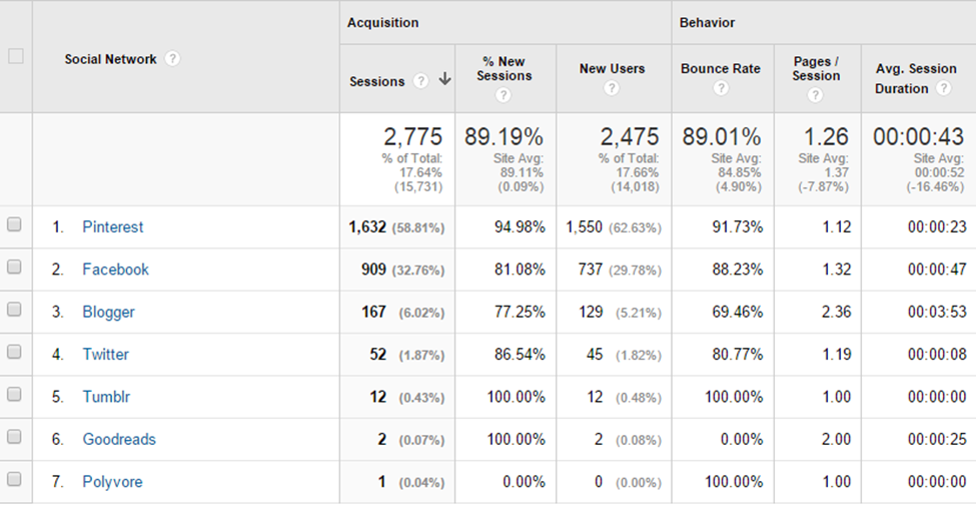
There are so many features, but even a quick look at my Analytics is helpful. If you need help installing, simply Google Installing Google Analytics on WordPress (substitute WordPress with whatever blogging platform you use) and you will be given detailed instructions.
Technique 7: Create an Optimized Page that Links to your Hedonic Blog Posts
There are ways to shift your hedonic content to make it more utilitarian and easier to optimize. For example, instead of “The Summer I Spent Gardening” write a post titled, “5 Keys to Back Porch Gardening in Arizona.” But “The Summer I Spent Gardening” may be a more compelling post, that’s more true to you as an author and writer, and is more compelling for your audience. (Ideally your website includes a mixture of oth hedonic and utilitarian content.)
Here are a few of the hedonic posts I have written on this blog:
- Writing is like kissing
- Writing is like plate spinning
- Writing is like exercising
I doubt that anyone in the history of Google has ever searched for the phrase Writing is like kissing. And if people aren’t searching for it, I can’t optimize for it.
So what I did is I waited until I had a group of enough hedonic posts all related to one subject. Then I did my keyword research and realized that lots of people were searching for the phrase Metaphors about Writing. And when I searched for that phrase on Google, none of the top-ranking posts used that phrase in their title. So I created a page on my website titled “Metaphors About Writing“:
My post uses the phrase “metaphors about writing” multiple times, and it’s in the title and the url. I found writing metaphors from various famous authors, including Ernest Hemmingway and Neil Gaiman. I mixed in these quotes with the metaphors I have created about writing and links to my pages.
This compilation page provides genuinely valuable content to teachers, students, and writers. It was worth my time because people interested in writing are part of the audience as a writer. And because I optimized the page for Google, it receives hundreds of visits a month. And every month, some of the readers click through and read my posts, including “Writing is Like Kissing.”
You can create compilation post about your hedonic content. This could be all the poems you have written about frogs, or your continuous, running commentary on some aspect of politics or the environment–whatever it is you’re writing about on your author blog, if it’s compelling, you’re probably writing about related things (or you could).
Technique 8: Post Consistently
You want your blog to be indexed (Google has to be aware of it in order to include it in search results). A website like CNN is crawled constantly and new results are added almost instantly to Google. I tend to post on this website at least once a month, so I can count on the fact that Google will crawl my site at least once a month and add new pages and blog posts to their search results. If I posted consistently once a week, I could count on Google indexing my site about once a week. If, however, I went six months without blogging, Google might start crawling my website less often, and it could take months after a new post for Google to notice.
When you’re working on your author website, you have to choose something that you can sustain. Personally, if I put up three posts up a week, I would not have time to write anything else. Set yourself a goal and make sure you post consistently. Not every post needs to be an opus, but it should add some sort of value for your readers.
Technique 9: Participate in Basic Linkbuilding
Linkbuilding is a huge, ever-changing part of SEO, and is not the focus of this post. However, there are three, easy things you can do that will help send links and boost the credibility of your author website or blog:
- Guest blogging: Write a guest blog post for another blog or for a site like Buzzfeed that allows contributor posts. Make sure your bio includes a link to your site, and not only will Google see you as more credible, but people may click through to visit your website.
- Turn mentions into links: If someone is mentioning you on the web already, ask them to turn your name into a link to your website.
- Relevant, non-spammy comments: If you are making relevant, non-spammy, non-trolling comments on blog posts, then choose the Name/URL option so your name includes a hyperlink to your website. And if it’s truly non-obtrusive, you can leave a comment along the lines of, “I really liked your discussion of ________. I wrote about a similar aspect on my blog at ________.”
Technique 10 (Advanced): Use Google Keyword Planner for More Search Details
This is a bonus technique if you want to take your optimization skills to the next level.
I love keywordtool.io because it tells you what people are searching for. But how many people are searching for a term? Which terms are most competitive. Google Keyword Planner is a free tool that will tell you.
First, I find keyword ideas using keywordtool.io:
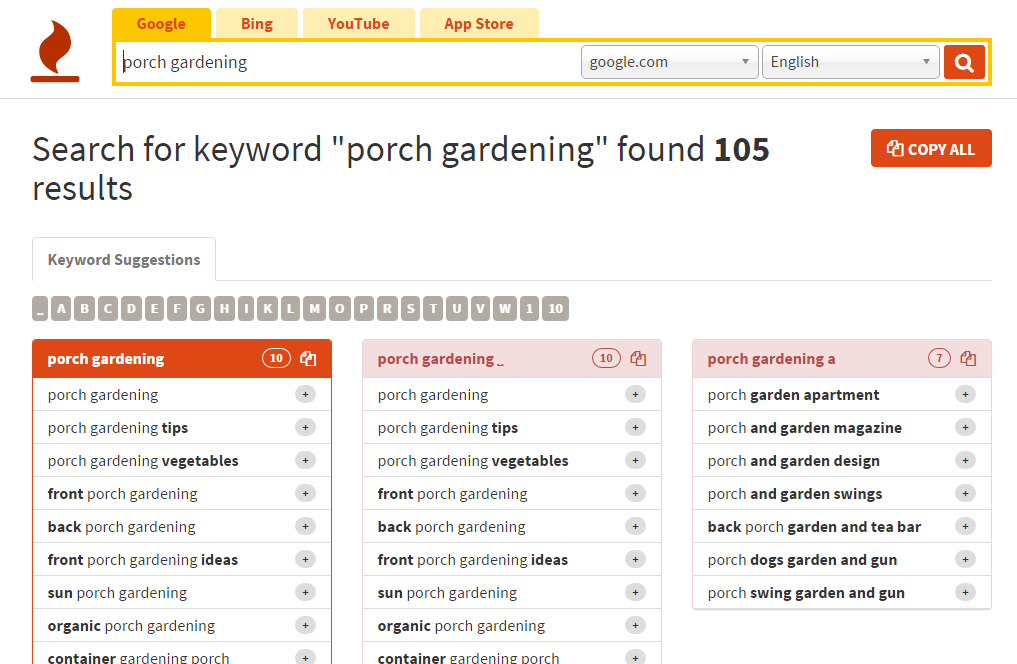
Then I go to Google Keyword Planner. They’ve now bundled it as part of Google Adwords, so you’ll have to set up an Adwords account, but you can do that without spending money. Once you’re logged in to Adwords click on “Search for new keyword and ad group ideas.”
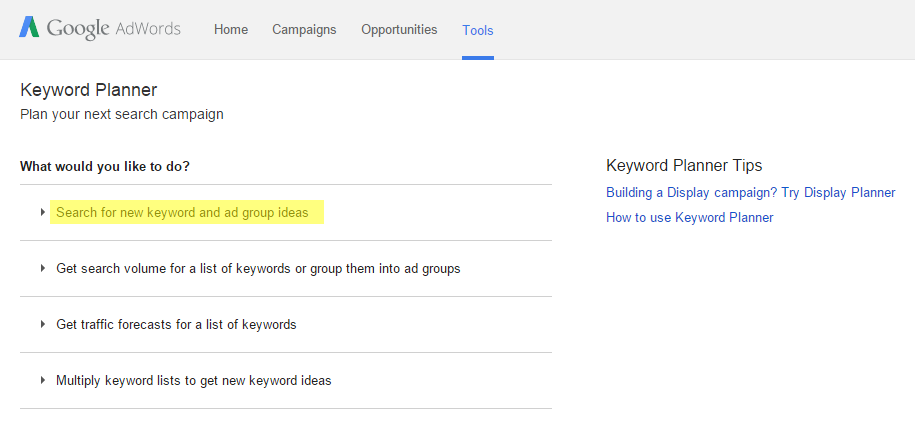
Enter some of the terms you are interested in as possible keywords for your blog posts or page, separated by commas. I never fill out the other details:
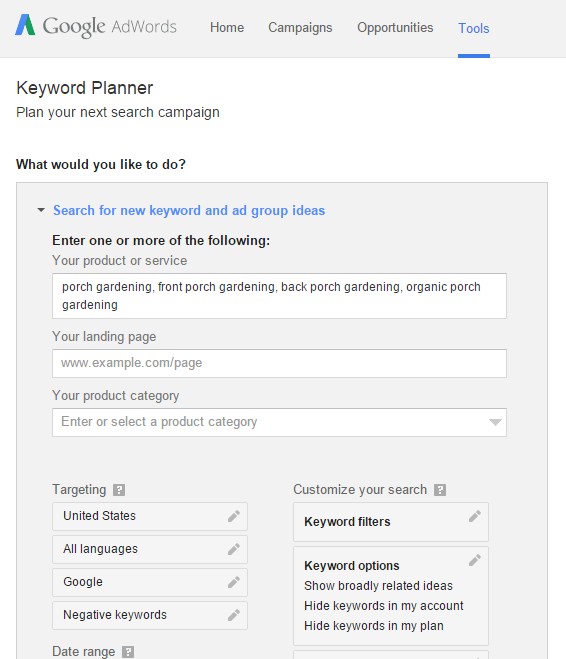
Once you’ve searched, you can see trends on when in the year people are searching more for these terms. Click on “Keyword Ideas” to see your keywords.
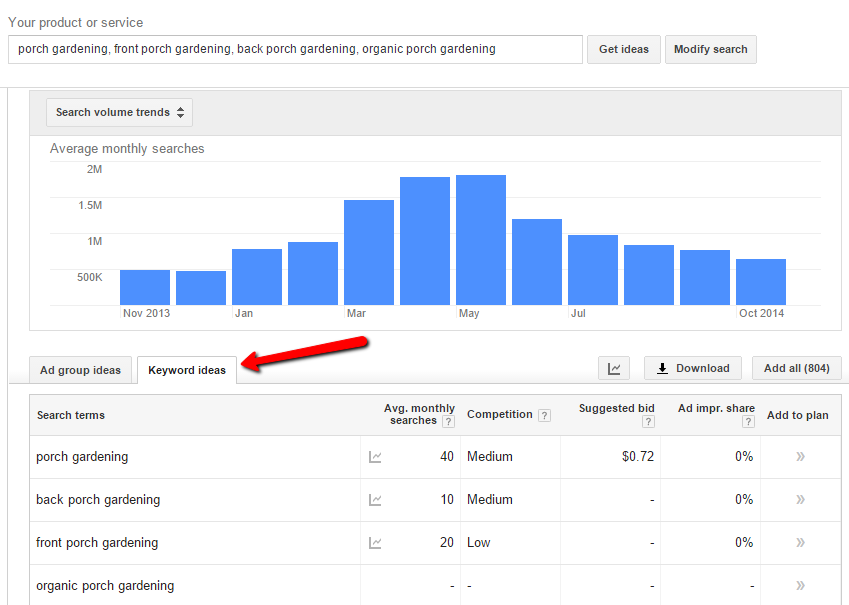
You can see how many people are searching for the term every month, and what the competition is. Because of the size of my website, I try to see if there’s anything with a higher number of monthly searches but low competition.
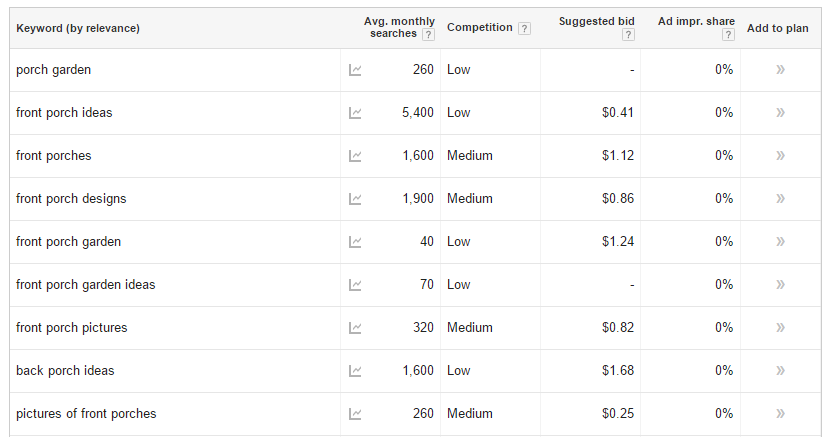
Ultimately, I want to write about something that means something to me as an author, and fits my website. But if I was already going to write about my front porch, I might as well include the phrase “front porch ideas” because I’m not going to have to change much about my post and I could get a lot of additional traffic. It worked for my writing dialogue in fiction post–because of Google Keyword Planner I decided to include 2 dialogue exercises, and I’m ranked #2 for “dialogue writing exercises” in Google and get a lot of traffic because of it.
In Close
You don’t have to optimize every post or page on your author website for Google. But if you’re writing a utilitarian post, one that people might search for, it’s well worth your time. And regardless of the type of post or page, you should take a few extra minutes to optimize it, if not for Google, then for Facebook and Pinterest. Because, as I mentioned in the first post in this series, you want your website to be Stimulating, Searchable, Shareable, and Savable.
Coming in the next few weeks:
-Optimizing Your Author Website for Facebook
-Optimizing Your Author Website for Pinterest
Optimizing Your Author Website or Blog
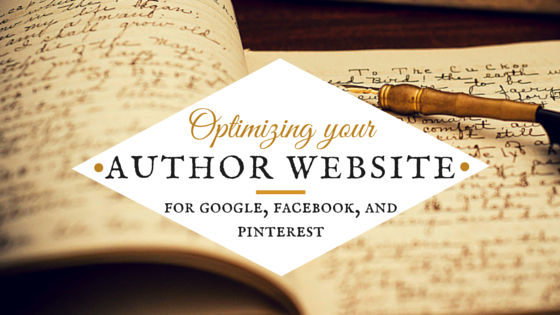
Andy Warhol talked about “15 minutes of fame,” and that’s what happens to most content posted on author websites or blogs. An author writes a blog post and shares it with her communities. It may have a bit of success, but then it disappears into the billions of pages on the Internet, never to be seen again.
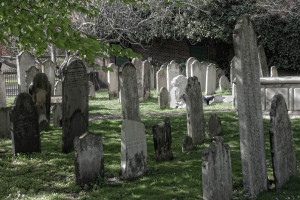
But that doesn’t have to happen.
Instead of being an abandoned grave, your blog posts can be the Taj Mahal, still a mausoleum, but with a lot more visitors. The truth is you don’t have to be a J.K. Rowling to get a steady stream of visitors to your website.

The key is slightly modifying your content in order to optimize for a few big platforms. This is greasing the wheel–taking your already good content and modifying it slightly, to create constant (or increasing) readership over time. In this blog series I will focus specifically on what you can do to your content itself. Marketing your website and yourself would be another series of blog posts by itself.
The Outline
Part 1 (this post) discusses why optimizing your author website is important. I’ll use examples from my own blog and introduce general principles, including the 4 S’s of good content.
Part 2, Google, highlights 10 easy ways to optimize you author blog/website for Google.
Part 3, Facebook, discusses 6 easy ways to optimize for Facebook.
Part 4, Pinterest, focuses on 8 easy ways to optimize for Pinterest.
This post is based on a presentation I gave at Tech PHX in November 2014. Many of the better ideas are borrowed from my husband, Scott Cowley, an internet marketer who spent years working in Search Engine Optimization (SEO). He’s currently pursuing a PhD in Marketing with a focus on Internet and Digital Marketing, and he approves the principles I discuss in these posts.
Case Study: My Website

I’ve owned this domain for quite a while, but it was in January 2013 that I decided to really launch it as an author website. An at that point I was an unpublished author, and unless you’re famous for something else, as an unpublished author you have absolutely no audience.
I revamped the design of my website and during January and February I wrote 8 blog posts. I installed Google Analytics so I could track my website’s performance. And in February 2013, after promoting my website to all my friends and family, I received:
- 127 unique visitors
- 250 page views
I have not been a prolific blogger: I’ve published, on average, 1.6 posts per month. Yet last month, in May 2015, I received:
- 2344 unique visitors
- 3111 page views
I have never had a post go viral, and my audience is still a fraction of what I want it to be. But with a handful of hours a month, the size of my audience has increased over 18 times. And while I’ve published a number of short stories, most of this traffic increase is due directly to optimizing my website, specifically for Google, Facebook, and Pinterest.
Some of this has happened unintentionally. One of all-time most visited blog posts is a humorous post titled “My Companion Llama.”
For a while if you searched for “companion llama” on Google I was ranked number 1 for the term. Fortunately I’ve dropped down to number 4, which is a good because most people searching for companion llamas are interested in getting their own companion llama, and not in reading a mildly mocking piece. But out of habit, I optimized for the term “companion llama,” and there wasn’t much competition, so I’m still ranking for it.
Most of my other blog posts I’ve intentionally optimized.
On the day I published “10 Keys to Writing Dialogue in Fiction,” I shared it on Facebook. Most of my friends aren’t interested in writing craft, and I received only 29 views. Honestly, that’s a little depressing. But because I optimized the post, since then I have received over 12,000 views on the blog post, and the number of readers continues to increase every single month.
How did I do it? First, let’s look at the big picture, the general principles.
The 4 S’s of Good Content
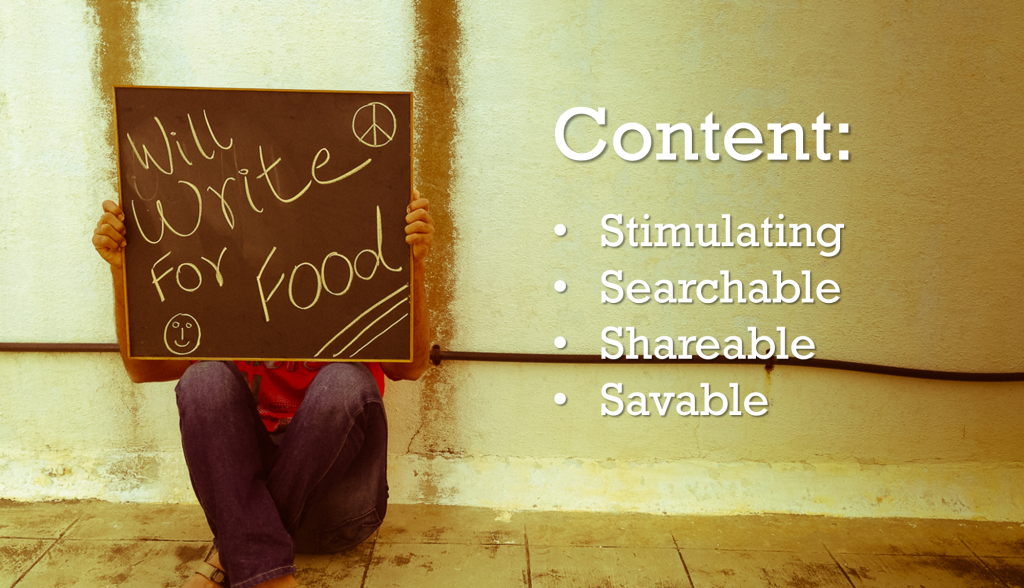
As you create your author website and add new blog posts, your content should be stimulating, searchable, shareable, and savable.
The first S is Stimulating.
If your content isn’t good, it doesn’t matter how much you optimize.
But how do you figure out what content will be stimulating for your audience?
My favorite advice on this subject actually comes from Aristotle. He wrote a book titled On Rhetoric over 2000 years ago. He focuses on three things in his text, which modern scholars call the rhetorical situation, or the rhetorical triangle.
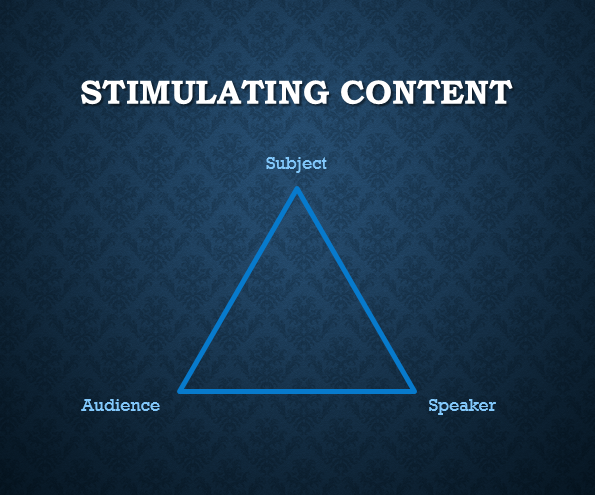
What is your subject matter? What does your audience look like, what do they care about, and what connects to them? And what makes you distinctive as a speaker or writer, that you can offer? Figuring out how the subject, the audience, and the speaker intersect is key to creating stimulating content. I could write a whole series of blog posts on this subject, but that will have to wait for another day.
Searchable, Shareable, and Savable
Once you have stimulating content, the next three s’s relate to optimizing your website and blog. Unless you want your content to die an early death, it must be searchable, shareable, and savable.
Searchable: Your content needs to be searchable by Google and other search engines. Pinterest and other platforms also provide search functions that drive a lot of traffic. If you are not receiving traffic by organic search, you are missing out on a huge opportunity.
Shareable: You have to package your content in such a way that people can share it easily and effectively. People are sharing content constantly on social media sites including Facebook, Twitter, and Pinterest.
Savable: People want to be able to come back to your content easily, but most aren’t going to use a traditional browser bookmark or create a list of links in a word file. People will save your content on Pinterest, Tumblr, and Facebook and they will come back to it later and return to your website.
Parts 2, 3 and 4 of this series will go in depth on easy, practical things you can do to make your author website searchable, shareable, and savable.
Moving Forward
Depending on what study you’re consulting, organic search (from Google and other search engines) accounts for 50-64% of website visits. It is the largest driver of web traffic. So that is the focus of Part 2:
Optimizing Your Author Website or Blog for Google
Related:
Part 3: Optimizing for Facebook
Part 4: Optimizing for Pinterest
(These follow-up posts will be published in the coming weeks.)
Image Credits:
Pen and notebook – Ray Sadler via flickr, Creative Commons license; Cemetery – Berit Watkin via flickr, Creative Commons license; Taj Mahal – Francisco Martins via flickr, Creative Commons license; Lllama – Mary via flickr, Creative Commons license; Will Write for Food – Ritesh Nayak via flickr, Creative Commons license.
Two New LDS Short Stories: “Yongrui and the Tree of Life” and “The Five Year Journal”
I don’t normally think of myself as a writer of LDS fiction, but I do occasionally write short LDS stories.
I have two that have recently been published.
“Yongrui and the Tree of Life”
“Yongrui and the Tree of Life” is a story about sickness and healing, faith and art. It combines Chinese and Garden of Eden mythology, brush painting, and family dynamics.
“Yongrui and the Tree of Life” won first place in the 2015 Segullah Fiction contest. Segullah is an online journal featuring the writing of LDS women.
“The Five Year Journal”
“The Five Year Journal” is a short story that examines four days in Hannah Rinehart’s life, over a five year period.
“The Five Year Journal” is a finalist in the 2015 Mormon Lit Blitz contest. Voting will take place at the beginning of June.
Image Credits: Chinese brushes image by smilla4 via flickr, Creative Commons license; journal by Smallest Forest via flickr, Creative Commons license
Cover Reveal: Steel and Bone Anthology
Sometimes there are events that make something feel real. Like having the cover of the book I’m going to be published in! Presenting… the cover of Steel and Bone. It’s a steampunk anthology featuring 9 stories. Coming in at 375 pages, there is everything from clairvoyance to floating islands to dinosaurs.
Here’s the cover of Steel and Bone:
As you’ll notice, my name is listed first, and my story, “The Clockwork Seer,” is the first in the collection. The official description of my story, per the back cover and the Goodreads page:
On an island of oddities, a young clairvoyant struggles for normalcy, but deadly automatons have other plans.
I am sort of in love with my story. It’s features a woman named Medina who has a typewriter in her hip. The typewriter, and her other clockwork parts, make it possible for her to survive her visions, which are so violent that otherwise they would be debilitating. Enter a musician from the mainland, mechanical monsters, and an adventure ensues.
I hope that, come June 27th, 2015, you’ll get to know Medina, the clockwork seer. Steel and Bone will be available as both a print book and an ebook. So go add it to Goodreads!
Edited to Add: you can now buy the book on Amazon or learn more about it on the book’s page on my website.
Two Years of Book Group

Two years ago I started a book group, with the help and encouragement of some friends. The advantage of starting a book group is that it runs the way I like book groups to run. Not to say that my book group is perfect, but I like it and attend every month.
We have read a fun variety of books, fiction, nonfiction, poetry, young adult, classics, and recently released. And two years later, to my surprise, people are still coming.
List of books we have read and discussed so far:
- April 2013: The Princess Academy by Shannon Hale
- May 2013: The Language of Flowers by Vanessa Diffenbaugh
- June 2013: The Good Earth by Pearl S. Buck
- July 2013: These is My Words by Nancy Turner
- August 2013: Heaven is Here by Stephanie Nielson
- September 2013: Crocodile on the Sandbank by Elizabeth Peters
- October 2013: The Last Lecture by Randy Pausch
- November/December 2013: The Christmas Sweater by Glenn Beck
- January 2014: The Power of Habit by Charles Duhigg
- February 2014: The Alchemist by Paulo Coelho
- March 2014: Picture Book Month
- April 2014: The Life of Pi by Yann Martel
- May 2014: The No. 1 Ladies’ Detective Agency by Alexander McCall Smith
- June/July 2014: Esperanza Rising by Pam Munoz Ryan
- August 2014: Fahrenheit 451 by Ray Bradbury
- September 2014: Divergent by Veronica Roth
- October/November 2014: A Bend in the Road by Nicholas Sparks
- November/December 2014: Poetry Month
- January 2015: Sorcery and Cecilia or The Enchanted Chocolate Pot by Patricia C Wrede and Caroline Stevermer
- February 2015: What Alice Forgot by Liane Moriarty
- March 2015: Half the Sky: Turning Oppression into Opportunity for Women Worldwide by Nicholas D. Kristof and Sheryl WuDunn
- April 2015: Sailing Alone Around the Room by Billy Collins
How the book group runs
Someone volunteers to host (or if no one volunteers, I recruit). That person chooses the book, either one with a book group copy at the library or one with at least a few library copies available. Everyone who wants to reads the book does so. (It’s an open invitation book group, so anyone can attend, and you’re not required to read–we’ve had been 3 and 15 people at every book group.) The hostess holds book group at her home (or at mine, if her own is not an option), leads the discussion, and normally provides some sort of treat. There’s also some socializing at the beginning and the end, but we always spend a decent chunk of time on the book.
Image Credit: Evan Bench via flickr, Creative Commons license
Breastfeeding Mama, at the Tempe Community Writing Contest
Question:
What do breastfeeding, Aztec fire rituals, family history stories, and porcupine quills have in common?
Answer:
They are all in my new essay titled “Breastfeeding Mama,” which won first place for adult nonfiction in the 2015 Tempe Community Writing Contest.
The History of the Essay:
I originally wrote this essay in January 2012 and submitted it to a writing contest. It sort of worked, but sort of didn’t. It then went through a number of further revisions. I even over-revised it to the point of ruining it. I took over a year off from the essay and then rewrote it, and started submitting it again.
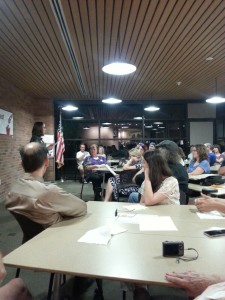 The Essay’s New Home:
The Essay’s New Home:
This year was the first time for the Tempe Community Writing Contest. The contest was a collaboration between the Tempe Public Library and Arizona State University. There were three categories of writing (fiction, poetry, and nonfiction) and three categories of people (adult, college student, and teenager). Almost 200 people submitted, and my essay was a co-winner for the Adult Nonfiction category.
Last night they had a reception at the Tempe Public Library, and winners got to read selections from their pieces. My husband counted, and there were about 80 people in the audience. And everyone laughed at my writing. Which actually made me very happy, as it is a humorous essay. It’s when you write a humorous essay and people don’t laugh that you need to worry. You should also worry when people throw tomatoes at you. But there were no tomatoes in the library. Only cookies. And (perhaps unfortunately) no one threw any cookies at me.
Read the Essay Online:
The book of winners published by the Tempe Library is available for free online: Tempe Writer’s Forum Volume 1. My essay starts on page 57 of the pdf.
(If you’re interested in reading the honorable mentions, they are available online as well.)
Content warning:
There are both breasts and babies in this essay, both of which are known to make some people feel supremely uncomfortable.
Original heart image by skyler817, Creative Commons license
